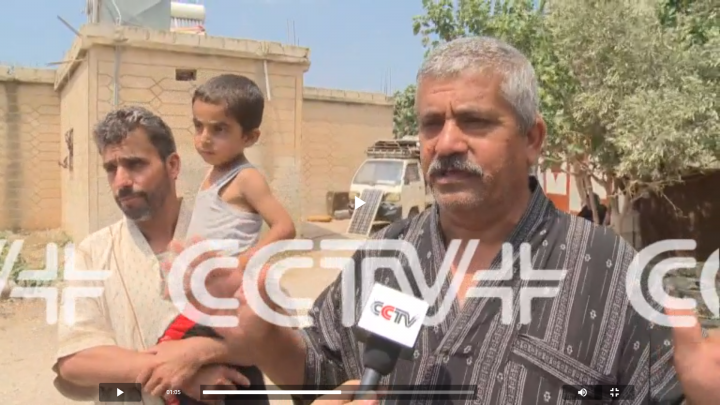“We have lived a frightening life in the past three years under the IS control. They robbed our house and furniture but did not give us money. When the Syrian army bombarded here, we escaped to the valley. Soldiers came over telling us not to escape because this area is under their control and there are no IS militants. We felt better.”
Salem Alhael, local resident
Storyline
The Syrian flag is again fluttering on the ground zero, a triangle of Syrian territory slicing between Jordan and the Israeli-occupied Golan Heights with the Syrian army taking full control of the Yarmouk Basin in southwestern Syria after routing Islamic State (IS) militants.
This triangle is located in the far western countryside of Syria’s southern province of Daraa, the birthplace of the Syrian war, which was recently recaptured by the Syrian army.
It is a high ground with a Syrian flag raised at its entrance and the Syrian soldiers seen standing guard looking both ways to Jordan and the Israeli-occupied territories. Turning right, an Israeli observatory is spotted from a distance on the Golan Heights; looking the other side, the Jordanian territories are seen.
During the crisis, the Syrian army almost lost all border points, except for a crossing with Lebanon. The Syrian government has repeatedly charged that weapons, munition, and fighters were being smuggled into the country from the loose border points that had fallen to the rebels.
During a wide-scale campaign that started in late June in Daraa and nearby rebel-held areas, the Syrian government forces have succeeded in restoring all border points with Jordan and were also deployed along the separation line with the Israeli-occupied Golan Heights.
The Golan Heights is a basaltic plateau spanning about 1,800 sq km captured by Israel during the 1967 Six-Day War.
This achievement is considered as an important victory for the Syrian army and a key step toward ending the Syrian war, as when the borders are controlled, the country becomes safer.
Capturing the borders also indicates that the Syrian army is gaining the upper hand in the Syrian war, after almost securing the southern region safe except for a few pockets controlled by the IS in the eastern countryside of Sweida province.
One week after capturing the Yarmouk Basin, the Syrian soldiers could temporarily have a rest while talking and drinking tea near a dam bordering Jordan before going to other battlefields. Also near the dam, a villager talked about his scary life under the IS control.
“We have lived a frightening life in the past three years under the IS control. They robbed our house and furniture but did not give us money. When the Syrian army bombarded here, we escaped to the valley. Soldiers came over telling us not to escape because this area is under their control and there are no IS militants. We felt better,” said Salem Alhael, a local resident.
Local villagers felt a little bit relieved after being freed from a long-time frightening IS control, but they still have to struggle for a living as there has been no enough daily necessities and electricity for several years, according to Alhael.
“Now what we need most is water. We have to drink. We have nothing but some food brought by the Syrian army. But we still need biscuits and water. We have been without electricity for seven years as electric wires and utility poles have been damaged and telephone lines have been also cut off. We lived in dark at night,” he said.
Now, the Syrian army is fighting the IS in the desert region in the eastern countryside of Sweida, making progress in the fight against the remaining IS pockets there.
The liberation of the Sweida desert will be the declaration of the entire liberation of the southwestern part of Syria, an achievement that would be the latest after the army has captured almost two-thirds of the country.










